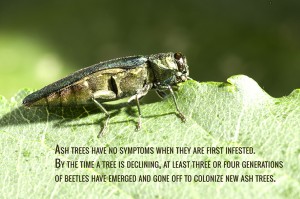
The emerald ash borer, a beetle that is killing trees all across the United States and Canada, arrived at least 10 years before it was first discovered in North America in 2002.
A new study, published in the journal Diversity and Distributions, shows that the beetles were feasting on ash trees in southeast Michigan by the early 1990s, says Deb McCullough, Michigan State University professor of forest entomology.
“We suspect they arrived inside wood crating or pallets imported from Asia where the beetle is native,” she says. “There were probably only a few live beetles that arrived, but ash trees are common in urban landscapes as well as in forests. When they emerged, there were likely ash trees nearby, providing food for the beetles and their offspring.”
Core Sampling
Slender cores were collected from the trunk of more than 1,000 ash trees across six counties in southeast Michigan. By studying the tree rings on each core and identifying key “marker” years, the team was able to determine the year each tree was killed by emerald ash borers.
This study, which encompassed more than 5,800 square miles, is by far the largest area sampled with tree rings. In addition, this was the first study to use tree rings to track the spread of an invasive tree-feeding insect.
The scientists found ash trees were killed as early as 1997. Since it takes many years before the beetle population was large enough to kill ash trees, the team concluded that the invasive species had been in southeast Michigan since 1992 or 1993 and perhaps even earlier.
Costly Insect
Emerald ash borers now have infested at least 22 states and two Canadian provinces and have become the most destructive and costly forest insect to ever invade North America, McCullough says.
“Emerald ash borers are killing trees so fast across such a large geographic area, that nobody actually knows how many trees are dead,” she says. “We do know there are tens of millions of dead ash in lower Michigan alone.”
Data from the tree ring study showed how the infestation grew and spread. Some of the spread was natural—adult beetles flying from one ash tree to another. However, people transporting infested ash trees from nurseries or as logs and firewood started new “satellite” populations. By 2003, they had expanded beyond the six counties encompassed by the tree ring study.
Part of the problem was the difficulty of detecting new infestations, says McCullough. Ash trees have no symptoms when they are first infested. By the time a tree is declining, at least three or four generations of beetles have emerged and gone off to colonize new ash trees.
In addition, reports of declining ash trees were not uncommon in Michigan and surrounding states in the 1990s. Problems ranged from road salt to drought to changing water tables. When shiny green beetles emerged from dying ash trees, however, researchers knew it was something out of the ordinary
Species Identification
Specialists at the Smithsonian Institute and London’s Museum of Natural History could not identify the beetles. Eventually, an entomologist in Slovakia, who intensively studied these and similar beetles, was able to identify the specimens. Still, the species had no common name until the MSU entomologists and their colleagues came up with “emerald ash borer.”
By the time Michigan identified the invader, ash trees across southeast Michigan were dead or dying, McCullough says. “We think emerald ash borers probably arrived from China, where they attack only very stressed or dying ash trees. Because of that, they are not considered an important pest in China.
“The Asian ash species have evolved with the beetles so healthy trees there are resistant to them. In North America, emerald ash borers would still prefer to attack stressed trees but it will do fine on healthy trees, too.”
Updated information on the insect is available at a site dedicated to current research that is exploring improved methods to detect new populations as well as identifying natural enemies of emerald ash borers imported from China that may become effective biocontrol agents.
Additional researchers from MSU and the US Forest Service helped coordinate the study.
Source: Michigan State University








